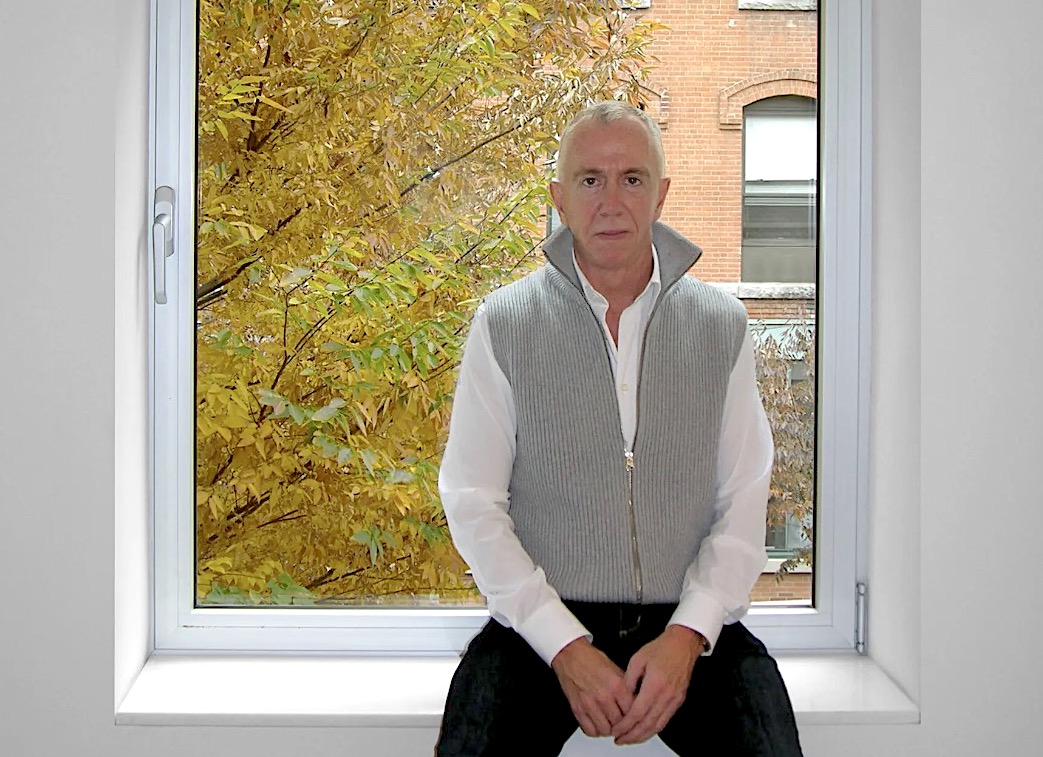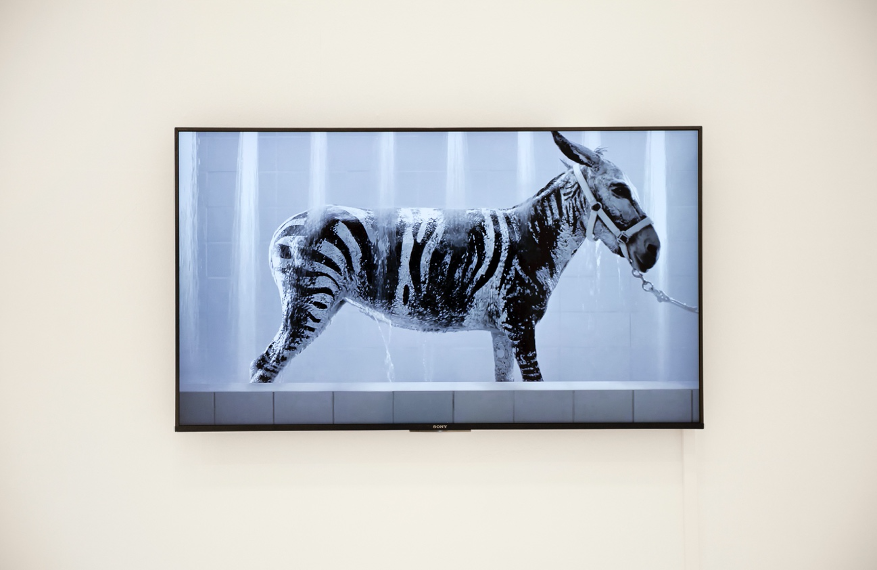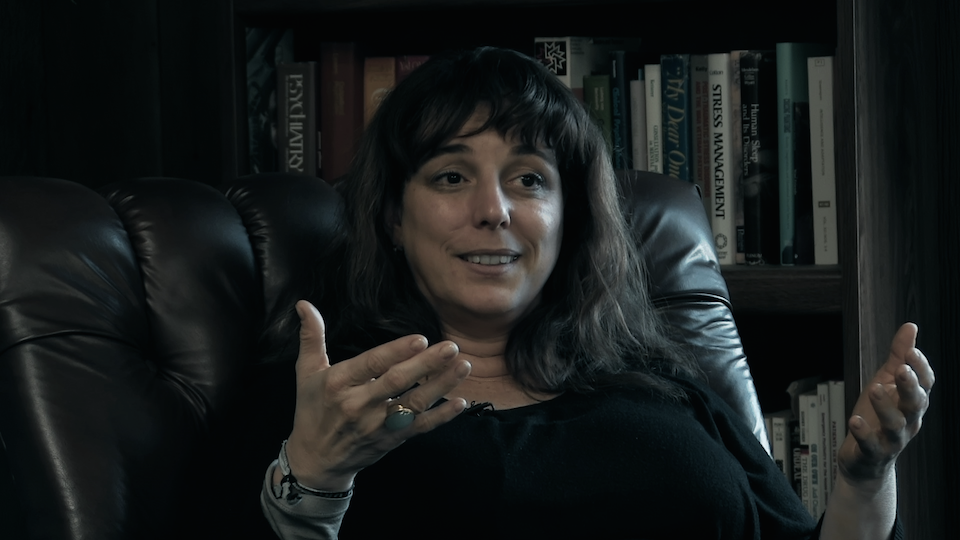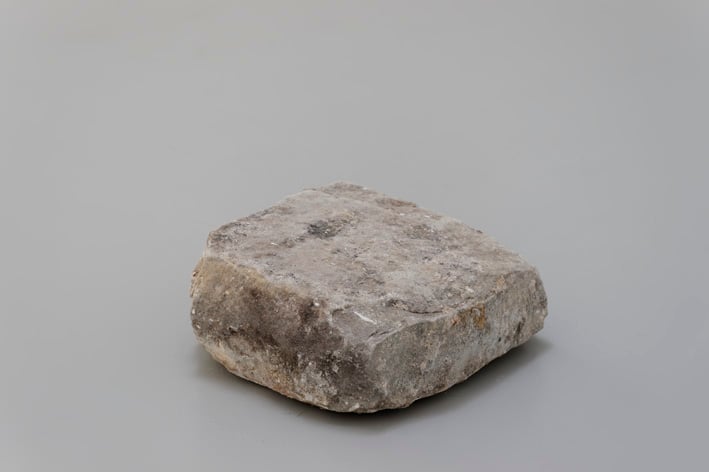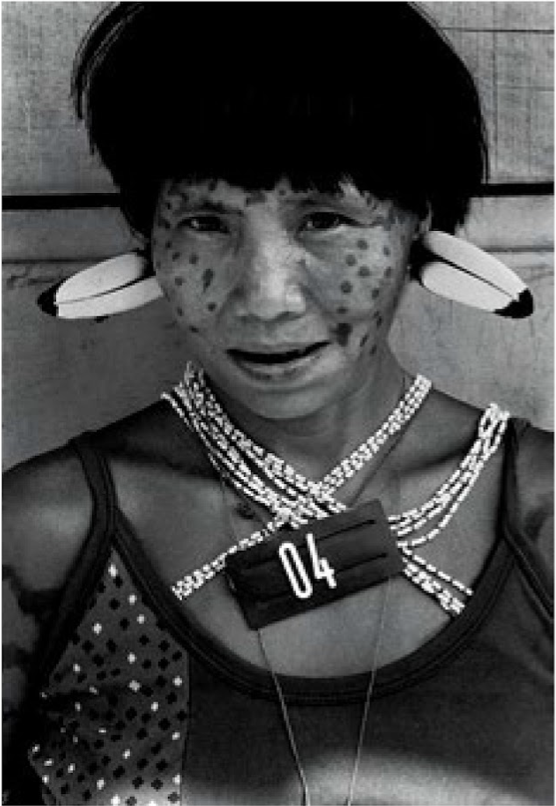
© » KADIST
Joe Namy
Joe Namy’s Half Blue is an installation consisting of a video, a sound, and a sculpture, that triangulates a personal experience of the artist’s cousin Khalid Jabara, who was murdered by hate crime in Tulsa, Oklahoma, U. S. A in 2016. An event that garnered international attention, Jabara’s murder led to the Jabara-Heyer NO HATE Act passed by US Congress in 2021. The act was named after Jabara and Heather Heyer, two hate crime victims whose murders were prosecuted as hate crimes but not reported in hate crime statistics.

© » KADIST
Subas Tamang
Drawing & Print (Drawing & Print)
Study of History III by Subas Tamang is an etching and aquatint print based on photographs taken by German photographer Volkmar Wentzel in 1949. Wentzel’s original color photographs document the transportation of a Mercedes Benz, carried on a wood armature by sixty porters, over a rocky trail from Bhimphedi to Kathmandu in Nepal. At the time of Wentzel’s photographs, paved roads in Nepal only existed within the Kathmandu Valley and cars had to be carried into the city from the surrounding hills on foot.

© » KADIST
Subas Tamang
Drawing & Print (Drawing & Print)
Study of History IV by Subas Tamang is an etching and aquatint print based on photographs taken by German photographer Volkmar Wentzel in 1949. Wentzel’s original color photographs document the transportation of a Mercedes Benz, carried on a wood armature by sixty porters, over a rocky trail from Bhimphedi to Kathmandu in Nepal. At the time of Wentzel’s photographs, paved roads in Nepal only existed within the Kathmandu Valley and cars had to be carried into the city from the surrounding hills on foot.

© » KADIST
Subas Tamang
Drawing & Print (Drawing & Print)
Masiniya Matawali by Subas Tamang is an etching and aquatint print based on photographs taken by German photographer Volkmar Wentzel in 1949. Wentzel’s original color photographs document the transportation of a Mercedes Benz, carried on a wood armature by sixty porters, over a rocky trail from Bhimphedi to Kathmandu in Nepal. At the time of Wentzel’s photographs, paved roads in Nepal only existed within the Kathmandu Valley and cars had to be carried into the city from the surrounding hills on foot.

© » KADIST
Carolyn Lazard
Between 1951 and 1974, Dr. Albert M. Kligman, a professor of dermatology at the University of Pennsylvania, oversaw medical experiments conducted on incarcerated people at Holmesburg Prison in Philadelphia. These nontherapeutic tests ranged from athlete’s foot powders, dandruff shampoos, deodorants, and detergents, as well as more hazardous materials such as dioxin, radioactive isotopes, and mind-altering psychotropics. During his tenure at Holmesburg, Dr. Kligman worked for companies such as Johnson & Johnson, developing the acne medicine Retin-A, and for Dow Chemical Company and the U. S. Department of Defence, testing the ‘tactical herbicide’ Agent Orange.

© » KADIST
Claudia Andujar
In 1980, with the construction of highways in Indigenous territories, an epidemic was brought to the Yanomami region. As the Yanomami do not have first names, it was necessary to give them numbers to indicate that they had already been vaccinated and identify each one for their medical records. From this series of events, Claudia Andujar’s Marcados series was born: what was supposed to be a mere photographic record, for organizational purposes, ended up raising a big question about the “labels” given to people in the construction of societies.
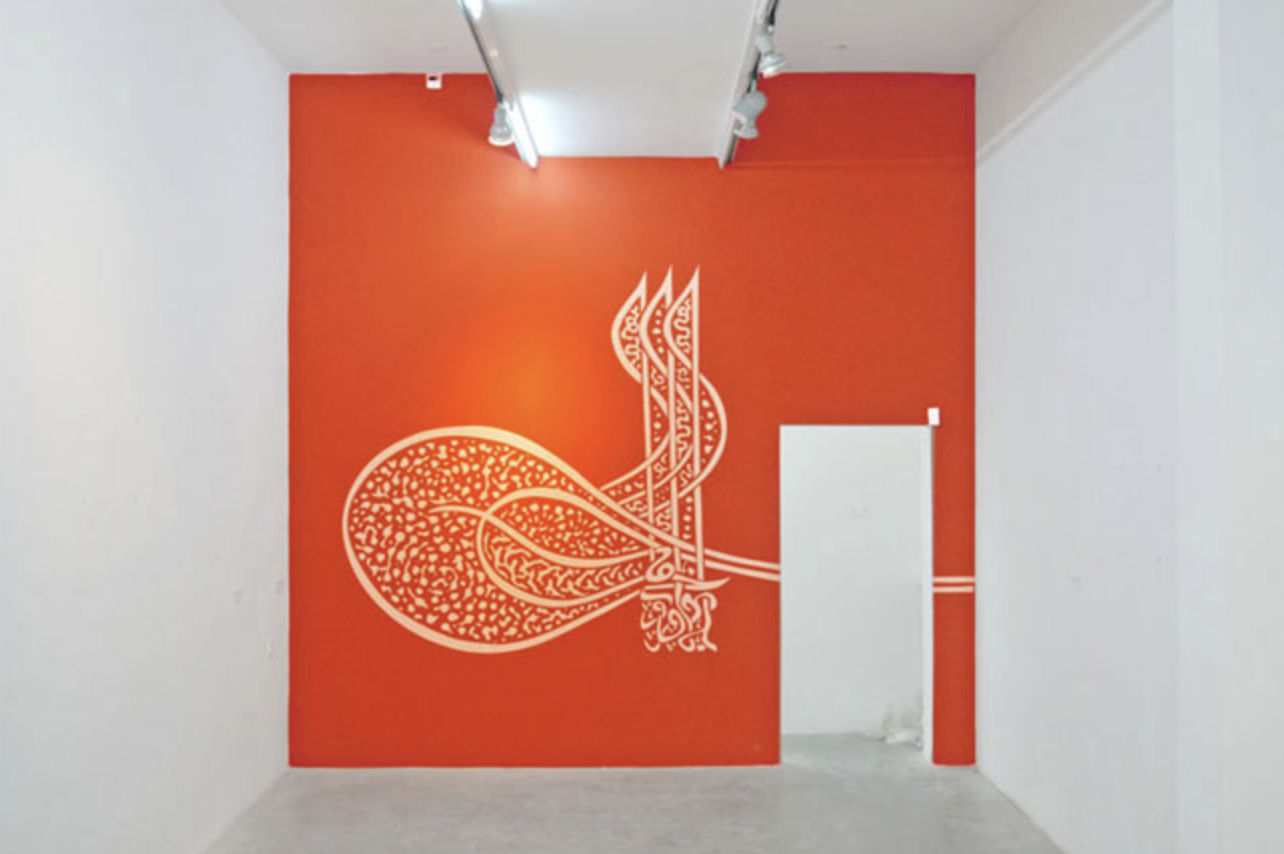
© » KADIST
Sharif Waked
Tughra is a protocol by Sharif Waked that reproduces the sixteenth century calligraphic monogram for tughra ; also known as the signature of Suleiman the Magnificent. Under Suleiman’s reign, at the beginning of the 16th century, the Ottoman empire achieved its apex both in terms of territorial extension and cultural creation. Suleiman personally instituted major judicial changes relating to society, education, taxation, and criminal law, as such he is often referred to as ‘The Lawgiver’.

© » KADIST
Birender Kumar Yadav
Drawing & Print (Drawing & Print)
Birender Kumar Yadav comes from Dhanbad, India, a city built on its proximity of iron ore and coal and once forested and inhabited by Indigenous people who compose the Gondwana. The forests were felled and immigrants from northern Bihar and South India were brought to exploit the mineral resources. The Indigenous people were then dispersed to live nomadically, engaging themselves as seasonal workers in farms and industries.
![Diálogo [Dialogue]](https://kadist.org/wp-content/uploads/2023/10/Dialogo-1-scaled.jpg)
© » KADIST
Patricia Belli
In the mid-1990s, Belli started to create soft sculptures that allowed her to reconnect with manual labor and sewing learned from her seamstress mother. Using recycled fabrics and objects collected from friends and second-hand stores in Nicaragua, Belli’s work explored the codification of family space—using dolls, tables, tablecloths, and curtains—making tangible how masculine authority is inscribed onto women’s bodies daily. Produced during her time as an MFA student at the San Francisco Art Institute, Diálogo is part of a group of sculptures that addresses the tension between restriction and agency, imprisonment and liberation, and ultimately, the possibilities and limits of human action in a society with deeply eroded democratic structures.

© » KADIST
Mona Marzouk
Trayvon is a series of acrylic paintings by Mona Marzouk that engages the courtroom as its points of departure. The courtroom as a space for the implementation of justice and of legal argumentation, but also through which different affective forces, some hegemonic and others marginalized, battle each other out in their respective quests for acknowledgment, accountability, and retribution. The work was produced at a time during which several popular revolts, such as in Egypt, seemed to have effectively been hijacked by reactionary forces, resulting in the violent dismissal of collective demands for emancipation, including through sham trials and wrongful convictions criminalizing activists, journalists, and protesters.

© » KADIST
Mona Marzouk
Trayvon is a series of acrylic paintings by Mona Marzouk that engages the courtroom as its points of departure. The courtroom as a space for the implementation of justice and of legal argumentation, but also through which different affective forces, some hegemonic and others marginalized, battle each other out in their respective quests for acknowledgment, accountability, and retribution. The work was produced at a time during which several popular revolts, such as in Egypt, seemed to have effectively been hijacked by reactionary forces, resulting in the violent dismissal of collective demands for emancipation, including through sham trials and wrongful convictions criminalizing activists, journalists, and protesters.

© » KADIST
Claudia Andujar
In 1980, with the construction of highways in Indigenous territories, an epidemic was brought to the Yanomami region. As the Yanomami do not have first names, it was necessary to give them numbers to indicate that they had already been vaccinated and identify each one for their medical records. From this series of events, Claudia Andujar’s Marcados series was born: what was supposed to be a mere photographic record, for organizational purposes, ended up raising a big question about the “labels” given to people in the construction of societies.

© » KADIST
Danielle Dean
In 2003, Nike released a pair of red and black sneakers (the Dunk Low Pro SB ) that were marketed as “vampire” sneakers. Danielle Dean’s work True Red examines how a large corporation co-opted a historical fiction (the vampire), in addition to the traditional red and black colors of radical politics and the avant-garde. The animated video considers how capitalism can gentrify notions of radicality and the mutable nature of advertising.

© » KADIST
Doreen Lynette Garner
Known But to God: The Dug Up, Dissected, and Disposed for the Sake of Medicine by Doreen Lynnette Garner is a small, suspended sculpture composed of glass, silicone, steel, epoxy putty, pearls, Swarovski crystals, and whiskey. At once attractive and repulsive, the sculpture combines objects of adornment with what appears to be viscera. The sculpture’s curious delicacy evokes a ritualistic catharsis, in response to persistent forms of medical racial violence and objectification for Black people in America and around the world.

© » KADIST
Uriel Orlow
The series The Memory of Trees is specifically about trees, and what trees have witnessed in South Africa: for example, trees that were used as locations for slave trading, or trees that was during the anti-Apartheid struggle as a kind of identifier for a safe house for activists who were fleeing from security forces. Trees and plants are connected and embedded in history; but not only as witnesses and onlookers; Orlow tries to think about plants as active agents in history. This perspective allows for an oblique view of history especially when it comes to specific loci of violence such as in South Africa.

© » KADIST
Goddy Leye
In Goddy Leye’s installation work The Beautiful Beast , a video is projected onto a gold-colored wooden box filled with sesame seeds. The sesame seeds look like pixels underneath the video, suggesting the texture of animation. The artist portrays a strange man who writhes on the ground like a beast against this ‘pixelated’ field.

© » KADIST
James "Yaya" Hough
Drawing & Print (Drawing & Print)
This untitled ink and pencil drawing by James “Yaya” Hough is made on what the artist calls “institutional paper”, or the state-issued forms that monitor the daily activities of prisoners, of which, each detainee is generally required to fill out in triplicate. This drawing uses a pink form on which an inmate can list telephone contacts for approval. The drawing depicts two uniformed figures, with backwards feet, berating a figure on a toilet.

© » KADIST
Troy Chew
Too Many Names by Troy Chew is a patchwork of contemporary Black culture and resistance, including hand-sewn symbols and patterns found in the coats of arms of the kings of the Dahomey region (now Benin) that ruled from 1600-1900. This painting is part of the series Out the Mud, a longterm project in which the artist explores African American history through the lens of traditional mudcloth techniques found in the West African countries involved in the Transatlantic-slave trade. The title of the series references the technique and materials for making mudcloth.

© » KADIST
Dread Scott
Drawing & Print (Drawing & Print)
This screen-print by Dread Scott titled Imagine a World Without America shows a map without the landmass that is the USA, as if the continents have drifted, or as if it never existed in the first place. Artist Dread Scott’s work is founded upon challenging “American patriotism as a unifying value,” and as such he claims that it is necessary to “burn the US Constitution (an outmoded impediment to freedom), and position the police as successors to lynch mob terror.” Perhaps one must imagine a structurally different world to produce new and freer modes of thought. While not explicitly related to Afro-Futurism, one of the key sub-genres of science-fiction and related thought is speculative revisionism; asking ‘how would the world be different if X never happened?” This modest work is a call to our daily imaginary, an invitation to zoom out to the scale of the global human condition, and implicitly America’s role in trade, war, cultural exchange, and the spread of western values.

© » KADIST
Zhou Tao
Zhou Tao spent almost two years in 2017 and 2018 in an eco-industrial park at the foot of the Kunlun Mountains in China exploring the activities of humans and other species in that particular topography between the mountain, the land and the desert. From the discovery of ancient desert villages to the billions of black chickens that will be raised under the snow-covered Kunlun Mountains, the resulting film and the photographs capture the climate and landscape, listening to the desert’s chanting and whispering, while attempting to construct a unique topology. Shot during the film production, the accompanying stunning photograph Winter North Summer South No.

© » KADIST
Apostolos Georgiou
Untitled (2016) is characteristic of the artist’s practice. Apostolos Georgiou invites us into a scene of cinematic tension. In the foreground, a man is kneeling with his hands on his head.

© » KADIST
Brook Andrew
This year: missing witness by Brook Andrew consists of a multi-layered collage of photographs. The work features newspaper cut-outs of the phrases: “This year: be prepared…” and “missing witness” overlaid onto a disaster scene, upon a worn-up manuscript. Pulled from The New York Times , the image is of a destroyed temple on the Indonesian island of Sulawesi, that has increasingly experienced natural disasters due to climate change.

© » KADIST
Tuan Andrew Nguyen
This work presents the image of an immolated monk engraved on a baseball bat. The flames surround him eroding the extremity of the bat. The delicate sculpture refers to the sacrifice of the Buddhist monk, Thich Quang Duc, who immolated himself on June 16th 1963, in reaction to the discrimination and the repressive politics of the Diem Catholic regime (regime installed by the Americans) towards the Buddhists.

© » KADIST
Zai Kuning
Drawing & Print (Drawing & Print)
Converting is a piece about the Orang Laut, often called Sea Nomads, that inhabited the Riau archipelago. They were Christians and pagans that were often oppressed by the majority Muslims in the Riau community and were eventually forced to convert to Islam. Zai conveyed this history in Converting through the stark contrasts of red, white, black.

© » KADIST
Akram Zaatari
“These are negatives that were scratched because of a jealous husband from the Baqari family, who never let his wife out by herself. He was upset to know that she came to be photographed in my studio without telling him. He came asking for the negatives.

© » KADIST
William E. Jones
In Restaurant, Canton, Ohio (2011), a convenience store offers food, liquor, and Coca Cola to an empty street. A series of boarded-up storefronts marred by peeling paint conveys a sense of the pre- or post-apocalyptic—the hush just before or after a disaster. The reds, pinks, and oranges of the buildings give off warmth, but the absence of human activity makes the glow eerie and strange.

© » KADIST
William E. Jones
In the early 20th century, the Hercules Engine Company was doing a brisk business producing customized, heavy-duty engines. Seventy years later, when the United States military started opting for Humvees and stock parts, the company began to fail, and it entirely ceased production in 1999. Hercules Engines, Abandoned, Canton, Ohio (2011) depicts the manufacturer’s former productive core, gone fallow.

© » KADIST
LaToya Ruby Frazier
LaToya Ruby Frazier is an artist and a militant; her photos combine intimate views of her relation with her parents and grandparents with the history of the Afro-American community of Braddock, Pennsylvania, where she grew up and where her family still live. She reports upon the decline of this steel-producing town, which was once prosperous and where the local population today is devastated by poverty, unemployment and health problems linked to pollution. The town has currently closed the hospital which increases unemployment and makes access to treatment complicated for the residents of one of the most polluted towns in the USA.

© » KADIST
Kara Walker
In her masterpiece 8 Possible Beginnings or The Creation of African-America , Walker unravels just that, the story of struggle, oppression, escape and the complexities of power dynamics in the history following slave trade in America. Her use of contour and silhouette accentuate emotion with rigor, she reduces the narrative to black and white as gruesome acts of sex and violence address trauma, fear and suffering through a majestic play of shadow and light.

© » KADIST
Hank Willis Thomas
Drawing & Print (Drawing & Print)
Shot in black and white and printed on a glittery carborundum surface, Black Hands, White Cotton both confronts and abstracts the subject of its title. As with many of his works, the artist has taken a found image and manipulated it to draw out and dramatize the formal contrast between the black hands holding white cotton. Cotton, of course is one of the most familiar fabric sources to us, and becomes incredibly soft once processed.
Subas Tamang
Part of the Indigenous Tamsaling community in Nepal, Subas Tamang comes from a family of traditional stone carvers...
Claudia Andujar
Claudia Andujar was born in Switzerland in 1931, and then moved to Oradea, on the border between Romania and Hungary, where her paternal family, of Jewish origin, lived...
James "Yaya" Hough
Working in ballpoint pen, pencil, and watercolor, often on the backs of bureaucratic prison forms, James “Yaya” Hough’s work conveys the burdens of incarcerated life, revealing not only the brutal reach of the carceral system, but laying bare its affects...
Birender Kumar Yadav
Birender Kumar Yadav is a multi-disciplinary artist who experiments with various media including painting, sculpture, photography, installation, etching, found and man-made objects, as well as live documentary...
Hank Willis Thomas
- location: New York, New York
- year born: 1976
- gender: male
- nationality: American
- home town: Plainfield, New Jersey
Mona Marzouk
Mona Marzouk is an artist whose practice is deeply rooted in a keen sense for architecture...
Zhou Tao
Artist Zhou Tao has a diverse and varied practice, and notably, he denies the existence of any singular or real narrative or space...
Uriel Orlow
In his research-based and process-oriented practice Uriel Orlow’s work is concerned with “spatial manifestations of memory, blind spots of representation and forms of haunting”...
Yee I-Lann
- location: Kuala Lumpur, Malaysia
- year born: 1971
- gender: female
- nationality: Malaysian
- home town: Sabah, Malaysia
Patricia Belli
Since the 1980s, Patricia Belli has been a driving force behind the rise of experimental work in Nicaragua...
Diego Bianchi
Since the early 2000s, Diego Bianchi has captured the atmosphere of a generation forged under a chronic state of crisis and precariousness in South America...
Goddy Leye
Born in 1965 in Mbouda (Cameroun), Goddy Leye was an artist, a teacher, a cultural activist and a curator based in Douala (Cameroun)...
Daniela Ortiz
In order to reveal and critique hegemonic structures of power, Daniela Ortiz constructs visual narratives that examine concepts such as nationality, racialization, and social class...
Apostolos Georgiou
Inescapably political, Apostolos Georgiou’s paintings are realized by bold and mastered brush strokes...
Ashmina Ranjit
Ashmina Ranjit is Nepal’s leading figure in the conceptual and performance fields, as well as an emblematic voice in South Asian feminist art making and activism...
Akram Zaatari
- location: Sayda, Al-Lubnan
- year born: 1966
- gender: male
- nationality: Lebanese
Kara Walker
- location: New York, New York
- year born: 1969
- gender: female
- nationality: American
- home town: Stockton, California
Sharif Waked
Sharif Waked is a Palestinian artist who’s work enages with with Islamic culture and history, and its interaction with the Israeli occupation and hegemonic Jewish culture in Palestine...
Brook Andrew
Brook Andrew is a Wiradjuri and Ngunnawal Aboriginal Australian artist and scholar whose interdisciplinary practice examines hegemonic narratives relating to colonialism and modernism...
LaToya Ruby Frazier
LaToya Ruby Frazier was born in 1982 in Braddock, Pennsylvania (USA)...
Dread Scott
Dread Scott is an interdisciplinary artist who for three decades has made work that encourages viewers to re-examine cohering ideals of American society...
Tuan Andrew Nguyen
Tuan Andrew Nguyen is an artist and filmmaker, one of the three founders of The Propeller Group created in 2006...
Joe Namy
Artist and musician Joe Namy’s practice encompasses sound, its history, and impact on the built environment...
Lynn Hershman Leeson
- location: San Francisco, California
- year born: 1941
- gender: female
- nationality: American
- home town: Cleveland, Ohio
Danielle Dean
Danielle Dean creates videos that use appropriated language from archives of advertisements, political speeches, newscasts, and pop culture to create dialogues to investigate capitalism, post-colonialism, and patriarchy...
Doreen Lynette Garner
Doreen Lynette Garner’s practice examines the histories and enduring effects of racial violence in the United States...
Danaya Chulphuthiphong
Working with both still and moving images, Danaya Chulphuthiphong is an activist and filmmaker whose work sheds light on social realities in Thailand...
Carolyn Lazard
Carolyn Lazard’s practice centers disability and accessibility through sculpture, video, installation, and performance...
Zai Kuning
- year born: 1964
- gender: male
- nationality: Singaporean
- home town: Singapore
-
1950-1959
Akram Zaatari
1957“These are negatives that were scratched because of a jealous husband from the Baqari family, who never let his wife out by herself...
-
1980-1989
Claudia Andujar
1984In 1980, with the construction of highways in Indigenous territories, an epidemic was brought to the Yanomami region...
Claudia Andujar
1984In 1980, with the construction of highways in Indigenous territories, an epidemic was brought to the Yanomami region...
Claudia Andujar
1984In 1980, with the construction of highways in Indigenous territories, an epidemic was brought to the Yanomami region...
Claudia Andujar
1984In 1980, with the construction of highways in Indigenous territories, an epidemic was brought to the Yanomami region...
-
2000-2009
Patricia Belli
2000In the mid-1990s, Belli started to create soft sculptures that allowed her to reconnect with manual labor and sewing learned from her seamstress mother...
Kara Walker
2005In her masterpiece 8 Possible Beginnings or The Creation of African-America , Walker unravels just that, the story of struggle, oppression, escape and the complexities of power dynamics in the history following slave trade in America...
Dread Scott
Drawing & Print
2006(Drawing & Print) This screen-print by Dread Scott titled Imagine a World Without America shows a map without the landmass that is the USA, as if the continents have drifted, or as if it never existed in the first place...
Goddy Leye
2009In Goddy Leye’s installation work The Beautiful Beast , a video is projected onto a gold-colored wooden box filled with sesame seeds...
-
2010-2019
William E. Jones
2011In Restaurant, Canton, Ohio (2011), a convenience store offers food, liquor, and Coca Cola to an empty street...
William E. Jones
2011In the early 20th century, the Hercules Engine Company was doing a brisk business producing customized, heavy-duty engines...
LaToya Ruby Frazier
2011LaToya Ruby Frazier is an artist and a militant; her photos combine intimate views of her relation with her parents and grandparents with the history of the Afro-American community of Braddock, Pennsylvania, where she grew up and where her family still live...
Tuan Andrew Nguyen
2012This work presents the image of an immolated monk engraved on a baseball bat...
Sharif Waked
2013Tughra is a protocol by Sharif Waked that reproduces the sixteenth century calligraphic monogram for tughra ; also known as the signature of Suleiman the Magnificent...
Yee I-Lann
2013Sarcastically titled to call attention to the problematic notions underlying colonialism, this photograph shows hundreds of Native Malaysians seated quietly behind one of their colonial oppressors...
Mona Marzouk
2014Trayvon is a series of acrylic paintings by Mona Marzouk that engages the courtroom as its points of departure...
Mona Marzouk
2014Trayvon is a series of acrylic paintings by Mona Marzouk that engages the courtroom as its points of departure...
Zai Kuning
Drawing & Print
2014(Drawing & Print) Converting is a piece about the Orang Laut, often called Sea Nomads, that inhabited the Riau archipelago...
Hank Willis Thomas
Drawing & Print
2014(Drawing & Print) Shot in black and white and printed on a glittery carborundum surface, Black Hands, White Cotton both confronts and abstracts the subject of its title...
Birender Kumar Yadav
Drawing & Print
2015(Drawing & Print) Birender Kumar Yadav comes from Dhanbad, India, a city built on its proximity of iron ore and coal and once forested and inhabited by Indigenous people who compose the Gondwana...
Danielle Dean
2016In 2003, Nike released a pair of red and black sneakers (the Dunk Low Pro SB ) that were marketed as “vampire” sneakers...
James "Yaya" Hough
Drawing & Print
2016(Drawing & Print) This untitled ink and pencil drawing by James “Yaya” Hough is made on what the artist calls “institutional paper”, or the state-issued forms that monitor the daily activities of prisoners, of which, each detainee is generally required to fill out in triplicate...
Uriel Orlow
2016The series The Memory of Trees is specifically about trees, and what trees have witnessed in South Africa: for example, trees that were used as locations for slave trading, or trees that was during the anti-Apartheid struggle as a kind of identifier for a safe house for activists who were fleeing from security forces...
James "Yaya" Hough
Drawing & Print
2016(Drawing & Print) This untitled ink and pencil drawing by James “Yaya” Hough is made on what the artist calls “institutional paper”, or the state-issued forms that monitor the daily activities of prisoners, of which, each detainee is generally required to fill out in triplicate...
Lynn Hershman Leeson
2016Tania Libre is a film by Lynn Hershman Leeson centered around renowned artist Tania Bruguera and her experience as a political artist and activist under the repressive government of her native Cuba...
Birender Kumar Yadav
2016Birender Kumar Yadav comes from Dhanbad, India, a city built on its proximity of iron ore and coal and once forested and inhabited by Indigenous people who compose the Gondwana...
Danaya Chulphuthiphong
2016The film Demos by Danaya Chulphuthiphong draws parallels between zoo animals and humans through an assemblage of footage and images collected from various news and science websites...
James "Yaya" Hough
Drawing & Print
2016(Drawing & Print) This untitled ink and pencil drawing by James “Yaya” Hough is made on what the artist calls “institutional paper”, or the state-issued forms that monitor the daily activities of prisoners, of which, each detainee is generally required to fill out in triplicate...
Doreen Lynette Garner
2017Known But to God: The Dug Up, Dissected, and Disposed for the Sake of Medicine by Doreen Lynnette Garner is a small, suspended sculpture composed of glass, silicone, steel, epoxy putty, pearls, Swarovski crystals, and whiskey...
Subas Tamang
Drawing & Print
2018(Drawing & Print) Study of History III by Subas Tamang is an etching and aquatint print based on photographs taken by German photographer Volkmar Wentzel in 1949...
Subas Tamang
Drawing & Print
2018(Drawing & Print) Study of History IV by Subas Tamang is an etching and aquatint print based on photographs taken by German photographer Volkmar Wentzel in 1949...
Subas Tamang
Drawing & Print
2018(Drawing & Print) Study of History V by Subas Tamang is an etching and aquatint print based on photographs taken by German photographer Volkmar Wentzel in 1949...
Diego Bianchi
2019Diego Bianchi’s main concern is distorting straight lines, both literally and metaphorically...
-
2020-2029
Brook Andrew
2020This year: missing witness by Brook Andrew consists of a multi-layered collage of photographs...
Subas Tamang
Drawing & Print
2020(Drawing & Print) Study of History VI by Subas Tamang is an etching and aquatint print based on photographs taken by German photographer Volkmar Wentzel in 1949...
Ashmina Ranjit
2020While most of Ashmina Ranjit’s work has been large-scale installations, often immersive and site-specific, the series Hair Warp – Travel Through Strand of Universe is a brilliant concentration of both her beliefs and aesthetic...
Subas Tamang
Drawing & Print
2021(Drawing & Print) Masiniya Matawali by Subas Tamang is an etching and aquatint print based on photographs taken by German photographer Volkmar Wentzel in 1949...
Daniela Ortiz
2021The Rebellion of Roots by Daniela Ortiz depicts a series of situations in which tropical plants, held hostage in the botanical gardens and greenhouses of Europe, are protected and nurtured by the spirits of racialized people who died as a result of European racism...










